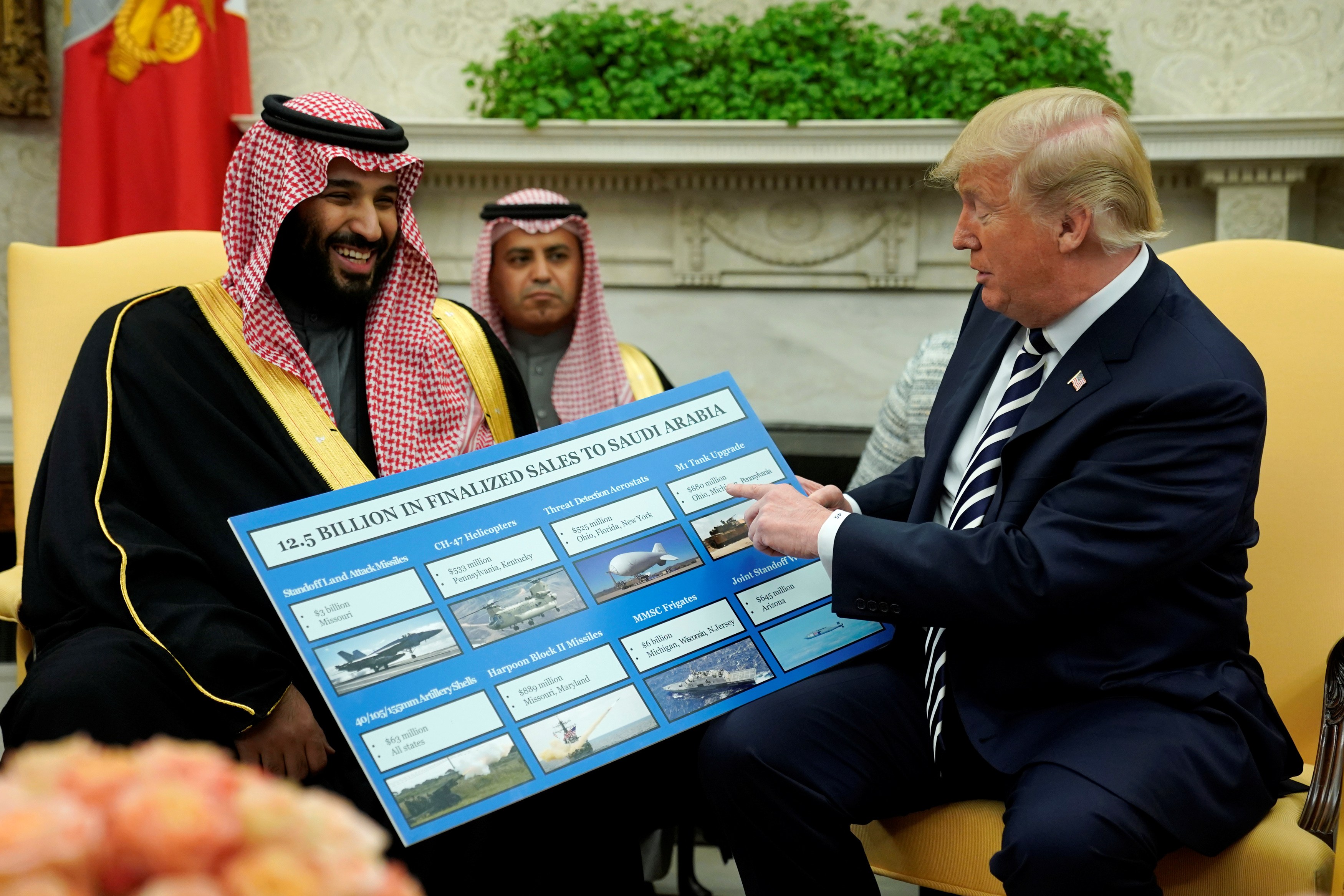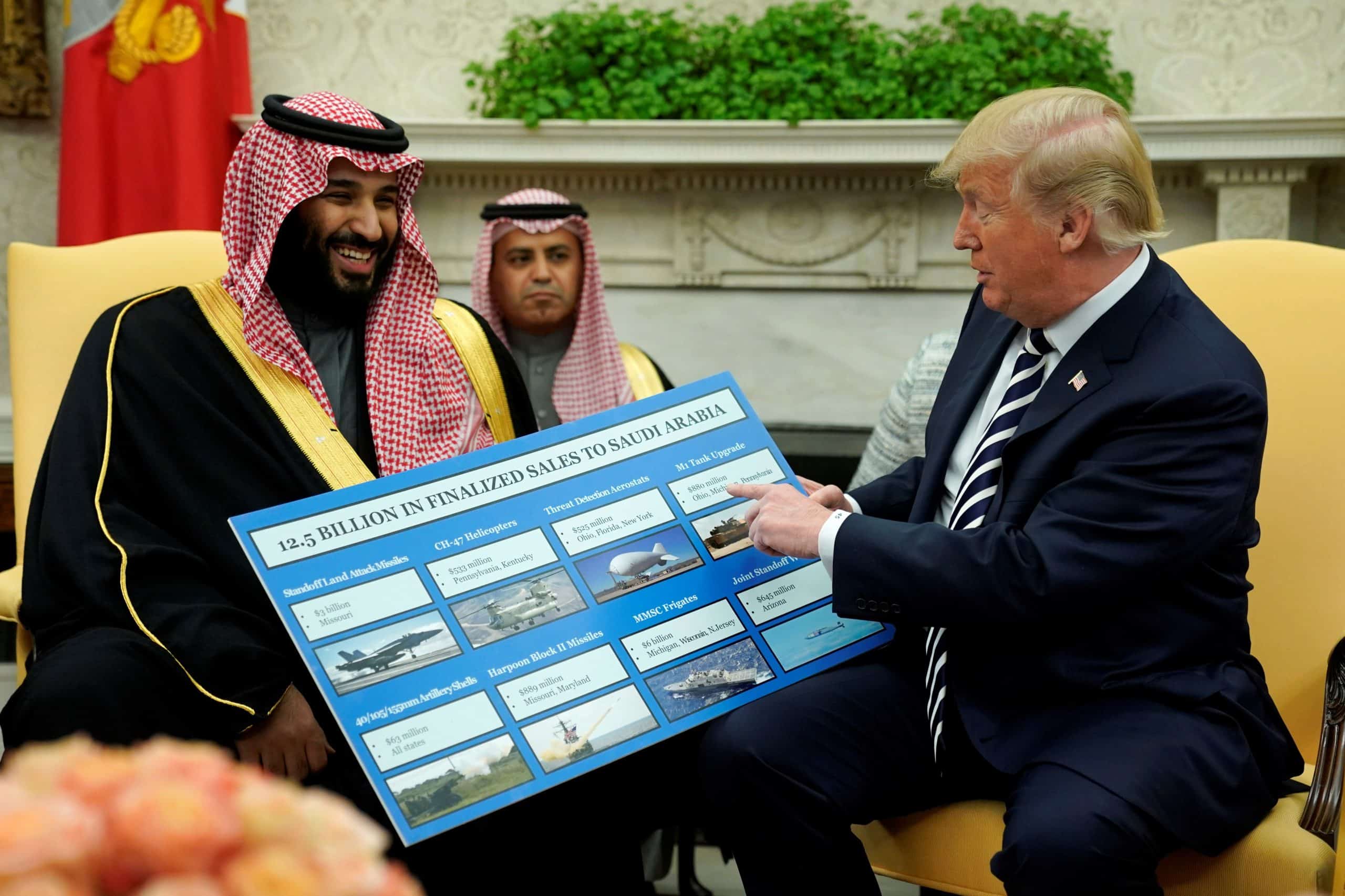
The week after the US, along with the UK and France, launched unilateral strikes against the Syrian government, the Trump administration is rolling out a “Buy American” weapons-selling initiative aimed at allowing other nations to buy even more weapons from US-based arms manufacturers. According to Reuters, the initiative, set to be announced today, will speed up the approval of arms deals to US allies and will call for members of President Donald Trump’s cabinet, as well as the president himself, to act as “closers” in major arms deals and salesmen for US weapons companies at international air shows and weapons showcases.
“This policy seeks to mobilize the full resources of the United States government behind arms transfers that are in the US national and economic security interest,” a White House official told Reuters. After news of the initiative first broke in the media, US weapons manufacturers made massive gains in the stock market and Raytheon’s stock hit an all-time high. In addition to helping the military-industrial complex secure more business, Trump may be pushing the initiative, at least in part, because of his personal investments in US weapons giants like Raytheon, Boeing and General Electric.
The initiative comes less than a week after the US strikes launched against Syria, and the strikes themselves were likely part of a PR bid to boost US weapons manufacturers and international arms orders leading up to the “Buy American” announcement. In addition, doubts have been raised that the strikes were planned to cause any major damage to the Syrian government, as the Syrian and Russian governments were allegedly “tipped off” by Trump prior to the attack, and given ample time to prepare by evacuating nearly all key military hardware.
This suggests that the purpose of the strike was not actually to harm the Syrian government as much as showcase US military might and weaponry in the lead-up to the official announcement of Trump’s new weapons selling initiative.
My missile’s better than your missile
Indeed, the US military, after the strike, praised the offensive for its “precision,” and the types of missiles and assets used – nearly all from US weapons giants like Raytheon, Lockheed Martin, and Boeing – figured prominently in media coverage of the strike. After the strikes, the stocks of US weapon manufacturers jumped sharply, adding nearly $10 billion to their market value. The strike also enriched the president himself by virtue of his stock holdings in Raytheon and Boeing.
The Syria strikes were also notable because they were used to debut new US-made missiles, which – unsurprisingly – received glowing reviews and a PR boost following the Syria strikes. Nineteen of those new missiles – the Joint Air-to-Surface Standoff Missiles, or JASSMs, manufactured by Lockheed Martin – were used for the first time in last week’s Syria attack after over 20 years of performance problems and other setbacks drastically delayed their development. However, their performance in the Syria strike conveniently proved a real-time “testing ground” for the missiles, and enough buzz for the missile’s troubled past to be forgotten. Further proof that the strikes were ordered with this purpose in mind is the fact that Lockheed Martin executives were preparing for a jump in JASSM orders before the strikes were even announced.
Using the Syria strike as a weapons-selling strategy may well have backfired, however. According to Russia, 71 of 103 missiles fired by the US, U.K. and France were shot down, resulting in a dismal success rate of around 31 percent and leading the coalition to hit only three of its original eight targets. It is likely for this very reason that the Pentagon has since changed its story by claiming that the US and its allies had always intended to hit only three targets, despite ample evidence to the contrary. Changing the narrative here is essential in attempts to boost US weapon sales — as admitting the success of the Russian-manufactured missile defense systems used in Syria would damage the sales of US missiles and bomber jets while boosting sales of Russian missile defense units.
Peanuts, popcorn, cool new missiles!
Trump’s bid to increase US arms sales, by using the Syria strikes as a PR blitz to show the effectiveness of US-made weapons, is just the latest action taken by the president to cement his role as America’s top arms dealer.
For instance, Reuters reported that Trump had personally intervened on behalf of Boeing, currently the US’ top weapons contractor, in a January phone call with the emir of Kuwait. During the call, Trump reportedly pushed the Kuwaiti leader to move forward on a $10 billion fighter-jet deal that Boeing considered “critical to its military aircraft division.” Trump’s presidency has thus far been incredibly kind to Boeing, which received $1.1 billion as a result of the Trump tax cut legislation and has seen its stock price double during his presidency.
More recently, Trump, during the recent visit of Saudi Crown Prince Muhammad bin Salman, held posters with pictures of US armaments and jets that had been sold to Saudi Arabia, smiling while boasting to reporters that “we make the best military product in the world.”
In addition, Trump has been working on rewriting the government’s Conventional Arms Transfer policy and the International Traffic in Arms regulations in order to make it easier to export more military-grade weapons. “It is about making sure we are doing everything we can to promote the competitiveness of American trade,” a State Department official told Politico last fall about the upcoming deal. Another similar effort taken up by the Trump administration involves using US diplomacy to assist US weapons companies obtain lucrative foreign-government contracts.
These changes, which the Trump administration plans to make official policy as soon as this week, have long been a major lobbying objective of the US weapons industry. Ultimately, though, they show that the military-industrial complex – long operating behind-the-scenes in US politics – is now set to become an integral part of the US’ public face, as Trump finds his niche “closing deals” for US weapon manufacturers around the world. Of course, with so many arms deals in the making, major wars and global conflicts likely aren’t too far behind.
Reprinted with permission from MintPressNews.


